|
Hasegawa's new-tool 1/32
scale
Focke-Wulf Fw
190A-8
by
Ian Robertson
|
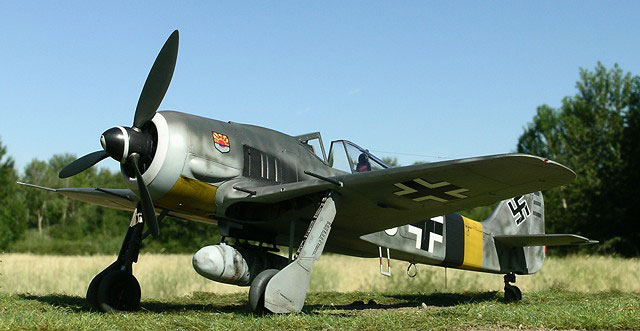 |
|
Focke-Wulf Fw 190A-8 |

Hasegawa's
1/32 scale Focke-Wulf Fw 190A-8
is available online from Squadron.com
This is Hasegawa's 1/32 Fw190A-8 in the markings of Rudolph Artner's
"White 10", 9./JG 5 Eismeer (Norway, 1945). For reference material I
relied on a photograph and color profile in Sundin and Bergstrom's "More
Luftwaffe Fighter Aircraft in Profile".
The markings for this scheme are included in the kit, although the
painting guide in the instructions is pretty vague and generic.
Jerry Crandall of Eagle Editions has already provided a
thorough and well-informed review of the Hasegawa 1/32 Fw190A-8 on
Hyperscale. The only comment I would add to his review is that
Hasegawa's instructions show the control stick installed backward in the
cockpit, so be sure to turn it around (like I did after a friend noticed
my error!).
Fine rivet detail was added to the fuselage, tail and wings using
Hasegawa's rivet-making tool and spacing template. Tamiya tape was used
to guide the placement of the template on the model's surface. Once the
rivets were in place, I polished the model's surfaces lightly with a
Micromesh sanding cloth to help tone down the visibility of the rivets.
I wanted the rivets to be barely noticeable rather than the first thing
to catch an observer's eye.
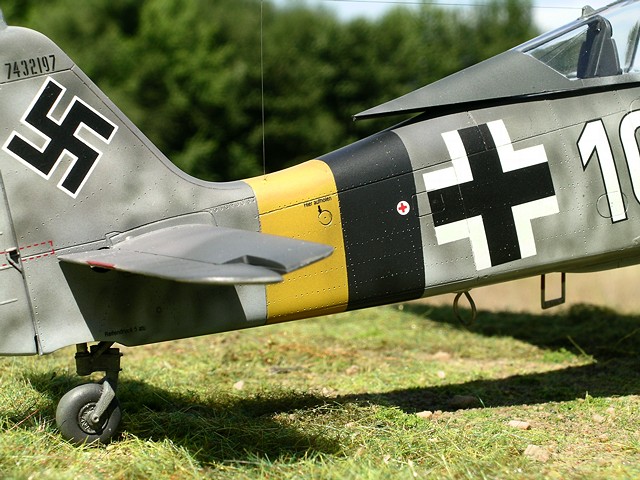
Although the kit's cockpit is well detailed, I replaced
the seat with one from Eagle Editions (an extra seat is supplied in
their Fw.190D-9 cockpit set), and I made my own seatbelts from lead foil
with brass buckles from MDC. The dials on the instrument panel were
added individually by punching them out from the kit's decal sheet using
a Waldron punch and die set. The cockpit was painted RLM 66 using Polly
Scale acrylic. A thin wash of reddish-brown enamel was used to flush out
details in the cockpit, and SnJ polishing powder was used sparingly to
simulate worn surfaces on the floor panels. Silver-colored pencil was
also used to highlight detail in the cockpit.
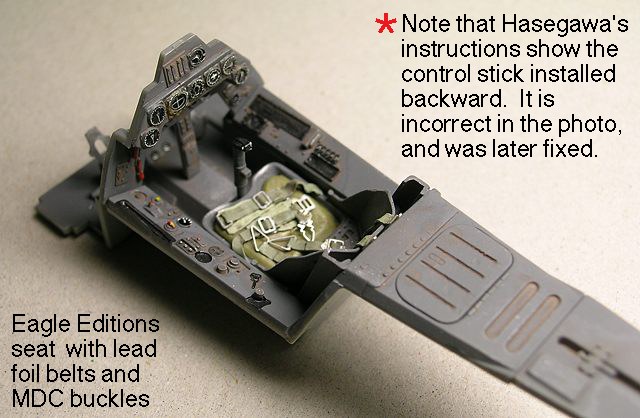
Note that the placement of the gun sight is incorrect in
the kit because it interrupts the padding that extends across the front
of the coaming above the instrument panel. I repositioned the gun sight
further forward and added a strip of styrene rod to fill the gap in the
padding. Both MDC and Eagle Parts correct this mistake in their cockpit
sets as well.
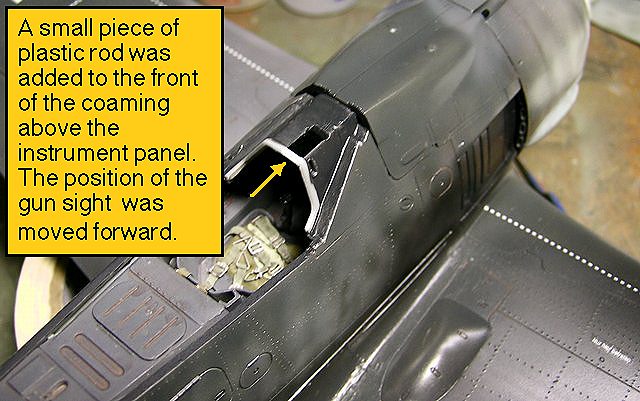
Much has been said about the awkwardness of the kit's
four-piece cowl, with more than a little of the anxiety caused by
memories of the fiddly multi-piece cowl on the 1/48 Trimaster/Dragon
Fw.190A/F kits. However, I didn't find the Hasegawa cowl difficult to
assemble at all. Simply make sure to fill the seams that don't belong
once the pieces are glued together.
Although Hasegawa provides an option for dropped flaps (at an incorrect
angle - they shouldn't drop more than 60 degrees), I decided to leave
the flaps up on my model. It was therefore necessary to remove the
positioning tabs before fixing the flaps onto the wing. I also found it
necessary to fill numerous sink marks on the outside surface of the
flaps caused by the internal detailing.
I opted to replace the kit's 300 liter drop tank with a more accurate
version from Eagle Editions. The replacement tank has the correct number
of panel lines, as well as some superb detailing revealed in the welded
seams and a separate fuel cap. I used a rotary dremel tool to create
dents on the front of the drop tank, as I've heard that these tanks
often suffered such abuse.

To each landing strut I added brake lines made from wire
and thin, flexible rubber. The oleos were covered with bare metal foil,
and the holes in the oleo scissors were drilled out. The tires
themselves were scored with a hobby knife to simulate a tread. Note that
Eagle Editions produces a replacement resin tire with the proper tread
pattern.
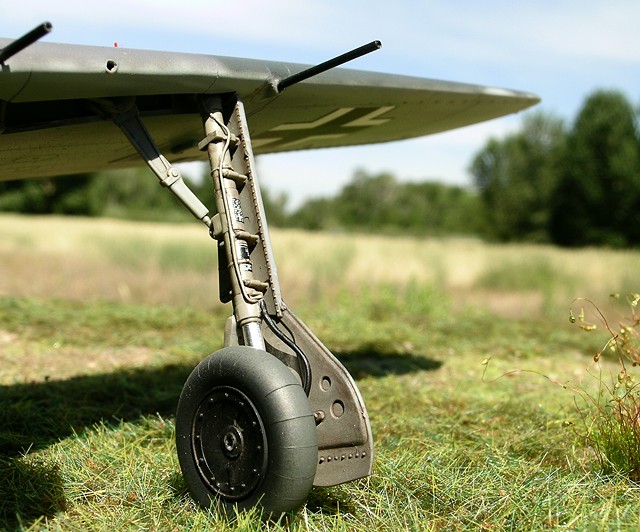
Painting,
Markings & Groundwork
|
Painting
 Painting
began with preshading the panel lines and various areas of the model in
black. Although the technique is disliked by some, I find it a great way
to enhance the character of a model. The key to preshading, in my
opinion, is subtlety. It should not be obvious to the casual observer
that the model was preshaded. Rather, preshading should create subtle
variations in the surface layer of paint that help create the illusion
that the aircraft's surfaces are not perfectly smooth or evenly worn. Painting
began with preshading the panel lines and various areas of the model in
black. Although the technique is disliked by some, I find it a great way
to enhance the character of a model. The key to preshading, in my
opinion, is subtlety. It should not be obvious to the casual observer
that the model was preshaded. Rather, preshading should create subtle
variations in the surface layer of paint that help create the illusion
that the aircraft's surfaces are not perfectly smooth or evenly worn.
The yellow and black fuselage bands, as well as the yellow cowl panel,
were painted and masked with Tamiya tape until all other painting was
complete. Although the kit's instructions do not show the yellow cowl,
both Eagle Edition's EagleCals#9 and the color profile in Sundin and
Bergstrom's book indicate that it was yellow.

The model was painted freehand with an Iwata HP-C airbrush using Polly
Scale acrylics in a standard Luftwaffe scheme of RLM 74 (dark gray), RLM
75 (gray-violet) over RLM 76 (light blue-gray). Special attention was
given to creating the fine vertical squiggles on the fuselage sides and
the mottles on the tail fin, consistent with my reference photo and
color profile. The spinner was painted black, and the propeller blades
were painted RLM 70 (black-green). Wheel wells and the inside of gear
doors were painted RLM 02 (gray).
Exhaust stains were sprayed using heavily thinned black paint. The
stains on the drop tank were achieved by spraying the same mixture of
black paint from up close above the tank, allowing it to be blown over
the sides and into the surface contours.
Once the paint was thoroughly dry, I sprayed a thin coat of Future floor
wax over the model to give it a glossy finish in preparation for decals.
Decals
Most of the decals I used were from the kit, although the stencils
and swastikas were from Eagle Editions. Contrary to previous
experiences, I had no difficulty with the Hasegawa decals silvering or
wrinkling. I used Solvaset to help snuggle the decals into the panel
lines and rivets. Once the decals had dried I applied a second coat of
Future, followed a day later by a 50/50 mixture of Polly Scale clear
satin and clear flat.
Groundwork
A wooden cutting board was used as the base for the model. Celluclay
was used to make the basic ground cover. The celluclay powder was mixed
into a paste with water and white glue, tinted with brown acrylic paint,
and then spread thinly over the cutting board. Note that the cutting
board had previously been treated with several coats of clear lacquer to
prevent warping while the celluclay dried. While the celluclay was still
wet I added pieces of Heki grass mat (item # 1574 - Wild Grass Savanna),
fine sand, and small bits of moss. I purchased the Heki grass from a
mailorder company in the UK. (Do a Google search on the term "Heki
Grass" and you will find suitable dealers.)
Images were taken with a Nikon Coolpix 5400 digital camera. The "sharpen
edges" tool of Adobe Photoshop was used to restore some of the clarity
and crispness lost during image compression.
Click on the thumbnails
below to view larger images:
Focke-Wulf Fw 190
Modelling Manuals 20 |
|
|
|
|
US Price: $17.95
UK Price: £12.99
Publisher:
Osprey Publishing
Publish Date:
May 25, 2002
Details: 64 pages; ISBN: 1841762687 |
|
|
Model, Images and Text Copyright ©
2004 by Ian Robertson
Page Created 13 July, 2004
Last Updated 12 July, 2004
Back to HyperScale
Main Page
|
Home
| What's New |
Features |
Gallery |
Reviews |
Reference |
Forum |
Search